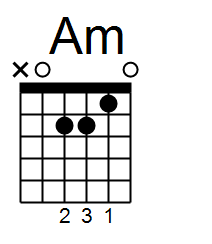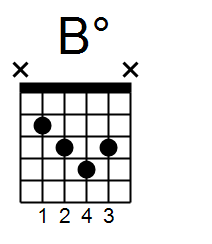In this section, we’re going to learn a couple more open chords. First up is G Major:

Here you’re strumming all six strings but focus on getting each note to ring out clearly. There are a couple of other ways you can play a G chord, here’s my personal favorite:

To mute the A string simple rest your second finger on it. Here’s another version for your to try:

Add the G Major chord to the ones you already know and practice changing between them. Try playing C – F – G – C and you have a chord progression used in literally thousands of songs.
Next up is A Minor or Am:

For this chord, you normally play don’t play the low open E string although there is an E in the chord as it will make the chord sound unbalanced.
The next chord we’re going to learn is B Diminished (Bdim or B°).
Now, beginners aren’t usually taught this chord until much later on but I’m including it to help explain a little theory in the next section, so don’t worry too much about it. You won’t find it 99% of simple chord progressions but if you want to hear it in action, check out ‘Private Investigations’ by Dire Straits and see if you can hear it. As you can see below, it’s not strictly an open chord either but this is the nicest fingering for it lower down the neck.

As you can probably hear, this chord creates a lot of tension and is unstable. Play it followed by a C Major chord to hear it resolve. Again, don’t worry about this chord for now, I just wanted to make you aware of it to save a lot of misunderstanding further down the line.
Checkpoint: You should now be able to play the seven chords we’ve learned in the first four sections cleanly and transition between them. If you’re not quite there, don’t rush it – you just need to put in the practice time and it’ll come quite naturally after a while.